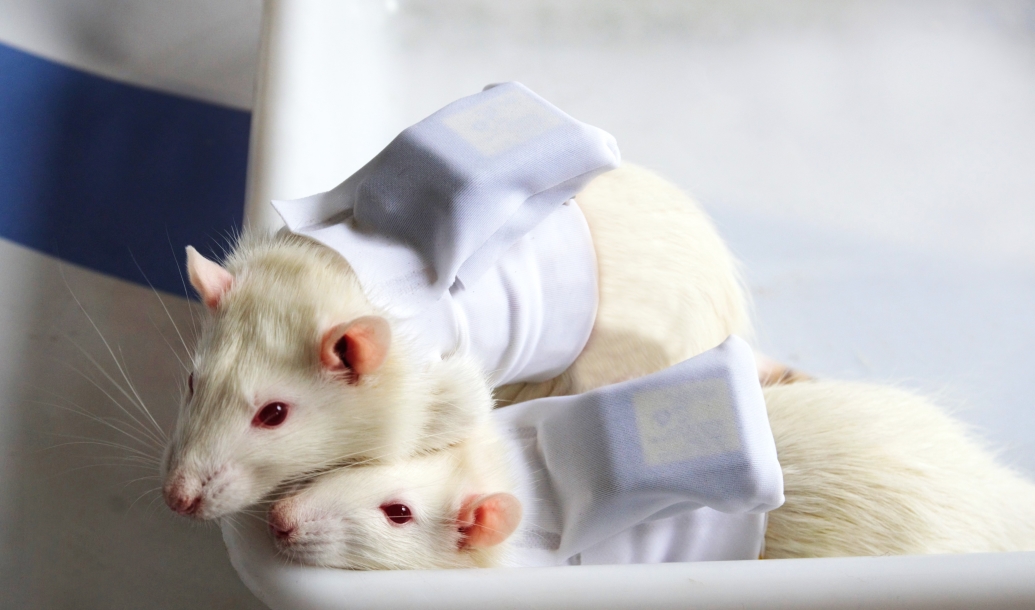Monitoring of vital functions
An effective approach to monitor health recovery or anticipate Human Endpoints after a surgery or a medical condition
Why it is important?
Most of vital function monitoring solutions primarily focus on intra-operative use, leading to a critical gap in physiological data once the animal recovers from surgery. Wearable telemetry closes this gap by enabling continuous, restraint-free, and non-invasive Home Cage Monitoring (HCM) of vital functions of the animals when they return from the operating room.
This approach enables researchers to monitor recovery of anesthesia on cardiac and respiratory function, alongside locomotor activity recovery, for extended durations from any location. This extended post-operative surveillance significantly reduces risk for the animal and facilitates early intervention by animal carers and veterinarians.
This approach allows for:
Monitoring of awakening following anesthesia: Monitoring of heart rate and respiratory rate as well as animal behavior (through activity intensity) after surgery with anesthesia for extended periods (12 to 24 hours).
Remote monitoring tracking: Remote access to vital signs of animals recovering from surgery, from the office or from home (VPN required).
Alerts : Configuration of physiological values to trigger alerts in case of alarming cardiorespiratory values.
Enhances animal welfare: Support animal care and early intervention.

Use Cases
Interested in real-time, non-invasive monitoring ?
Intraoperative Monitoring
DECRO external telemetry can be used during surgery to monitor heart rate and respiratory rate in real time. This allows researchers to assess the animal’s health status and adjust anesthesia as needed.
Supporting Humane Endpoints
At the request of ethics committees, DECRO telemetry can help anticipate humane endpoints in animals that have undergone severe procedures, by continuously tracking physiological signs that indicate distress or deterioration.
Continuous Monitoring in the Home Environment
DECRO telemetry enables 24 to 48 hours of continuous monitoring of vital functions in rats housed in their cages, as well as in mini-pigs or dogs in their home pens.
Animals can be accommodated in pairs during recordings, maintaining natural housing conditions while collecting high-quality physiological data.
Resources on Vital Functions Monitoring
Continuous non-invasive extraction of hemodynamic variables from thoracocardiographic signals using the ensemble averaging technique: validation in anesthetized rats without ventilatory support
Leandro Fontana-Pires1, Stephane Tanguy1, Agathe Cambier2, Charles Eynard2, Timothé Flénet2, Julie Fontecave-Jallon1, Francois Boucher1 and Pierre-Yves Gumery1 ¹ Univ.Grenoble Alpes, CNRS, UMR 5525, VetAgro Sup, Genoble INP, TIMC, 38000 Grenoble, France² R&D...
Jacketed Telemetry with Integrated ECG electrodes: A Comparison with Traditional Implants in Beagle Dogs
FARES Raafat1, BENDRIMIA Anes1, BOUARD Delphine1, CAMBIER Agathe2, NADJAR Clémence2, EYNARD Charles2, FLENET Timothé2, Pascal CHAMPEROUX1 1ERBC Chemin de Montifault, 18800 Baugy, France2R&D Department, ETISENSE, Lyon, RHONE, FranceAbstract Jacket telemetry...
Eplerenone treatment limit electrocardiogram alteration in a non-diabetic chronic kidney disease rat model
Matthieu Soulié1, Tania Sanchez-Bayuela1, Agathe Cambier2, Frédéric Jaisser1 ¹ Inserm, UMRS 1166, Paris, France² Physiological monitoring instruments, ETISENSE SAS, Lyon, France https://doi.org/10.1161/hyp.82.suppl_1.079Abstract Background: Chronic Kidney Disease...
Jacketed telemetry in rats: a novel non-invasive method for cardiorespiratory phenotyping during treadmill exercise
Stephane Tanguy1, Agathe Cambier2, Leandro Fontana-Pires1,2, Timothe Flenet2, Charles Eynard2, Julie Fontecave-Jalon1, Pierre-Yves Gumery1 and François Boucher1 1 Universite Grenoble Alpes, CNRS, UMR 5525, VetAgro Sup, Grenoble INP, T IMC, 38000 Grenoble, France2...
Explore Other Applications
Phenotyping of disease models
Monitoring of ECG morphological changes, ventilation, and locomotor activity patterns changes to better characterize pathological phenotypes and understand underlying pathophysiological mechanisms.
Pharmacology and safety-toxicology
Assessment of the efficacy and toxicity of novel pharmacological compounds on cardiorespiratory and central nervous system (CNS) functions in rodent and non-rodent species using jacketed telemetry.
Education and Training
Learn physiology and pharmacology using jacketed telemetry on rehomed animals, or through a new digital approach with pre-recorded, on-demand datasets from cardiorespiratory studies.
Veterinary
Use wearable telemetry to monitor vital signs (heart and respiratory rates) or the development of medical conditions (e.g., cardiopathy), either at home or at the veterinary clinic.




